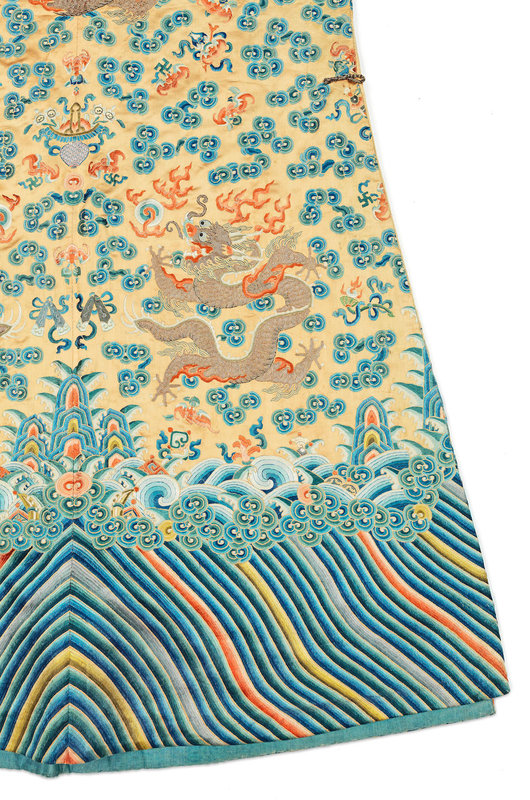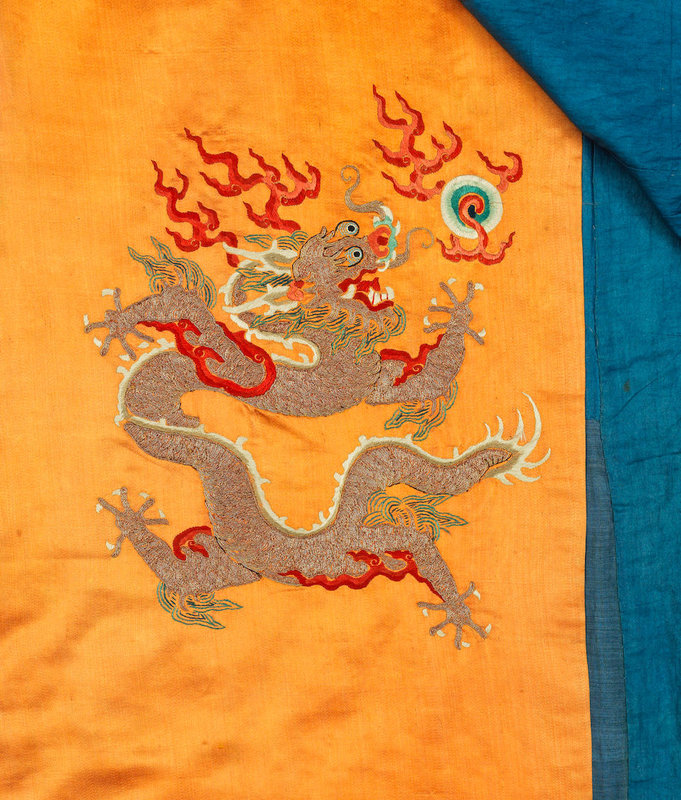A rare imperial apricot-ground embroidered silk woman's 'dragon' robe, Mid 19th century
Lot 286. A rare imperial apricot-ground embroidered silk woman's 'dragon' robe, Mid 19th century; 186cm (73 2/8in) wide x 133.5cm (52 2/8in) long. Sold for £ 19,000 (€ 22,569) (Est: £10,000 - £15,000). © Bonhams 2001-2021
Finely worked on the front and back in satin stitch and couched gold threads with nine writhing five-clawed dragons pursuing flaming pearls amidst dense trailing scrolls of five-coloured clouds interspersed with bats, all above the terrestrial diagram and the lishui stripe at the hem picked out in vibrant shades of blue, yellow, red, coral and green, all reserved on a deep apricot ground, the matching dark-blue-ground collar and cuffs worked with further dragons amidst further bats, clouds and waves, dragons bands, and nine dragons amidst further bats, clouds and waves, lined in a blue support silk.
Provenance: a distinguished Belgian private collection.
Note: The delicate tailoring and vivid depictions of dragons clutching flaming pearls, suggest that this robe would have been worn by an Imperial Manchu consort. According to the 'Illustrated Regulations for the Ritual Paraphernalia of the Imperial Court' Huangchao liqi tushi 皇朝禮器圖式, edited in AD 1759, the apricot-orange colour xinghuang of this fine robe was one of the 'Five Imperial Yellows' that could only be worn by the Heir Apparent to the Emperor, as well as Princes and Princesses of the First Rank and Imperial Consorts of the Second and Third Degree; see M.Medley, The Illustrated Regulations for Ceremonial Paraphernalia of the Ch'ing Dynasty, London, 1982, and L.Wrigglesworth, Imperial Wardrobe, Berkeley, 2002, pp.14-30.
The 'Regulations' confirmed the importance of a new type of robe, the jifu or longpao, as semi-formal Court wear and brought the cosmic purpose of Imperial rule into sharp focus. The careful arrangement of sinuous dragons writhing amid clouds and above the universal ocean washing against the earth mountain, quickly transcended the political and ethnic priorities of Imperial government to become universal symbols of the Empire.
Dragon robes thus became supreme significant social markers representing access to power. The right to wear such garments was dependent on rank and status. The Manchu rulers of the Qing dynasty were keen on projecting an evocative and powerful image of themselves, and their Court costumes conveyed legitimacy and heritage. Despite their initial reluctance to wear the same type of robes as their Ming predecessors, by the reign of the Kangxi Emperor, the Manchu elites were keen wearers of richly-ornamented 'dragon' robes on semi-formal Court occasions and official duties.
In Han Chinese thought, the five-clawed dragon was the quintessential symbol of Imperial power, embodying royalty, dominion and expressing the visual metaphor of the good ruler who behaved wisely for the wellbeing of his subjects. Capable of flying high in the sky and diving back into the sea, dragons were regarded as intermediaries between Heaven and Earth and credited with extraordinary powers that compared to those of the Emperor. Even the number nine, for the dragons depicted on the present robe, is highly evocative and likened to the power of Heaven. The multiple of three threes, nine has a long association with the Emperor. In addition, the 'Records of the Grand Historian' Shiji, completed during the first century BC, recounts that, having tamed the floods that once engulfed the land, the mythical Emperor Yu divided the territory into the Nine Provinces and collected bronze in tribute from each one. Thereafter he cast the metal into nine large tripod cauldrons. These vessels thus were at the heart of a ruler's possessions and symbolic conveyers of power.
The Qing robes, however, had their own distinctive shapes and trimmings. For example, the slits appearing at the centre seams, at the front and back hem, as well at the sides, were Manchu innovations that made it comfortable for the garment to be worn during riding. In addition, dragon robes were secured at the waist with ceremonial belts suspending narrow and straight streamers, and sometimes, purses. Other conspicuously-displayed accessories further identified Manchu dress, such as a hat, a surcoat and a necklace; see V.Garrett, Chinese Dress From the Qing Dynasty to the Present, 2008, North Clarendon VT, pp.16-17.
Compare with a similar apricot-ground silk 'dragon' robe, mid-19th century, illustrated by V.Garret, Chinese Dress. From the Qing Dynasty to the Present, Berkeley, 2008, p.32, fig.49.
A related apricot-ground formal Court silk 'dragon' robe, jifu, mid-19th century, was sold at Christie's London, 12 May 2017, lot 290.
Bonhams. Fine Chinese Art: Including Imperial and Court Textiles Curated by Linda Wrigglesworth, London, 2 november 2021

/https%3A%2F%2Fprofilepics.canalblog.com%2Fprofilepics%2F1%2F0%2F100183.jpg)
/https%3A%2F%2Fstorage.canalblog.com%2F03%2F02%2F119589%2F96711876_o.jpg)
/https%3A%2F%2Fstorage.canalblog.com%2F11%2F31%2F119589%2F94773502_o.jpg)
/https%3A%2F%2Fstorage.canalblog.com%2F20%2F83%2F119589%2F94772815_o.jpg)
/https%3A%2F%2Fstorage.canalblog.com%2F26%2F72%2F119589%2F75604929_o.jpg)
/https%3A%2F%2Fstorage.canalblog.com%2F59%2F60%2F119589%2F26458628_o.jpg)







/http%3A%2F%2Fstorage.canalblog.com%2F52%2F15%2F119589%2F126895380_o.jpg)
/http%3A%2F%2Fstorage.canalblog.com%2F25%2F07%2F119589%2F126043150_o.jpg)
/http%3A%2F%2Fstorage.canalblog.com%2F54%2F83%2F119589%2F126043104_o.jpg)
/http%3A%2F%2Fstorage.canalblog.com%2F53%2F67%2F119589%2F92818383_o.jpg)